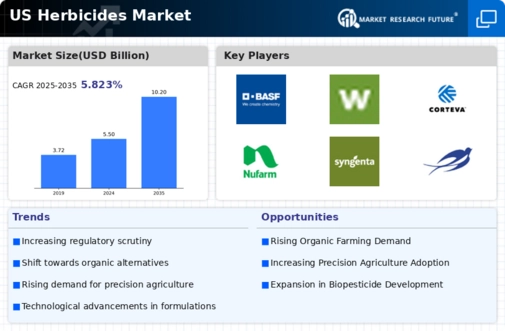Rising Demand for Food Security
The increasing global population and the corresponding demand for food have led to a heightened focus on agricultural productivity. In the US, the herbicides market is experiencing growth as farmers seek effective solutions to manage weeds that compete with crops for nutrients and water. The US Department of Agriculture (USDA) indicates that agricultural output must rise by approximately 70% by 2050 to meet food demands. This scenario drives the herbicides market as farmers adopt advanced herbicide technologies to enhance crop yields and ensure food security. Furthermore, the integration of herbicides in crop management practices is seen as essential for maintaining the efficiency of food production systems, thereby reinforcing the importance of herbicides in modern agriculture.
Regulatory Changes and Compliance Requirements
The herbicides market is influenced by evolving regulatory frameworks that govern the use of agricultural chemicals in the US. Stricter regulations aimed at minimizing environmental impact and ensuring food safety are prompting manufacturers to innovate and reformulate their products. Compliance with these regulations often requires significant investment in research and development, which can lead to the introduction of safer and more effective herbicides. The USDA has noted that the market is adapting to these changes, with a growing emphasis on products that meet regulatory standards while still providing effective weed control. As a result, the herbicides market is likely to experience shifts in product offerings and increased demand for compliant herbicide solutions.
Increased Adoption of Integrated Pest Management
The herbicides market is being positively impacted by the growing trend of integrated pest management (IPM) practices among US farmers. IPM emphasizes the use of multiple strategies to control pests and weeds, including the judicious use of herbicides. This approach not only helps in managing weed resistance but also promotes sustainable agricultural practices. The USDA reports that a significant number of farmers are now incorporating IPM into their crop management systems, which often includes the strategic use of herbicides. As awareness of the benefits of IPM continues to rise, the herbicides market is likely to see increased demand for products that align with these practices, thus fostering a more sustainable agricultural landscape.
Growing Awareness of Environmental Sustainability
The herbicides market is increasingly shaped by the rising awareness of environmental sustainability among consumers and farmers alike. There is a growing demand for herbicides that are not only effective but also environmentally friendly. This trend is prompting manufacturers to develop formulations that minimize ecological impact while maintaining agricultural productivity. The USDA indicates that a significant portion of the market is shifting towards sustainable herbicide options, reflecting consumer preferences for eco-conscious products. As sustainability becomes a central theme in agriculture, the herbicides market is expected to evolve, with an emphasis on products that align with these values, potentially leading to new market opportunities and innovations.
Technological Advancements in Herbicide Development
Innovations in herbicide formulations and application techniques are significantly influencing the herbicides market. The development of new active ingredients and formulations that target specific weed species with minimal environmental impact is becoming increasingly prevalent. For instance, the introduction of herbicides with enhanced efficacy and reduced toxicity is appealing to farmers who are concerned about sustainability. According to the USDA, the market for herbicides in the US is projected to reach approximately $4 billion by 2026, driven by these technological advancements. Additionally, the rise of digital agriculture tools that assist in the precise application of herbicides is likely to further enhance the efficiency and effectiveness of weed management strategies, thereby propelling the herbicides market forward.

















Leave a Comment